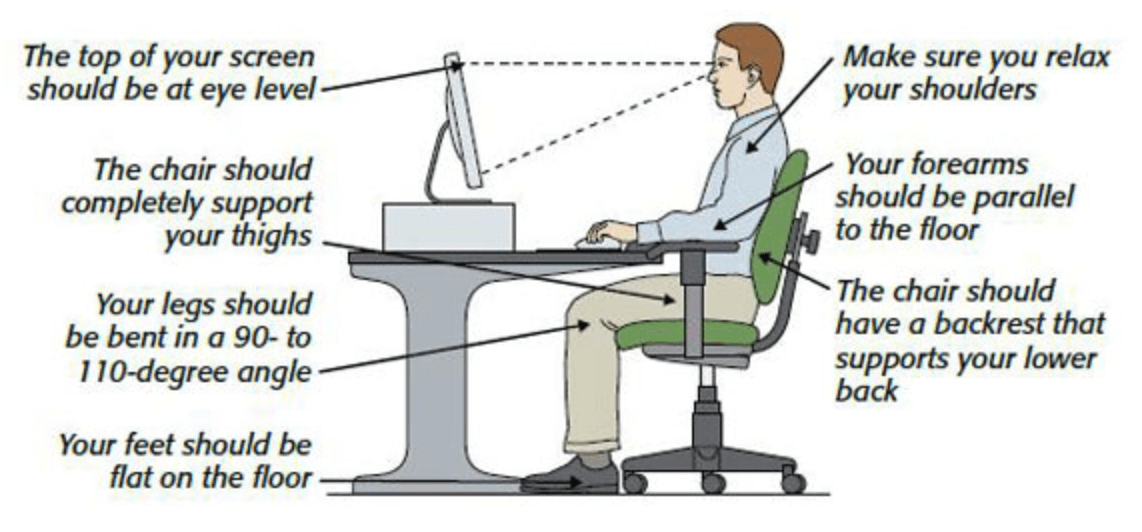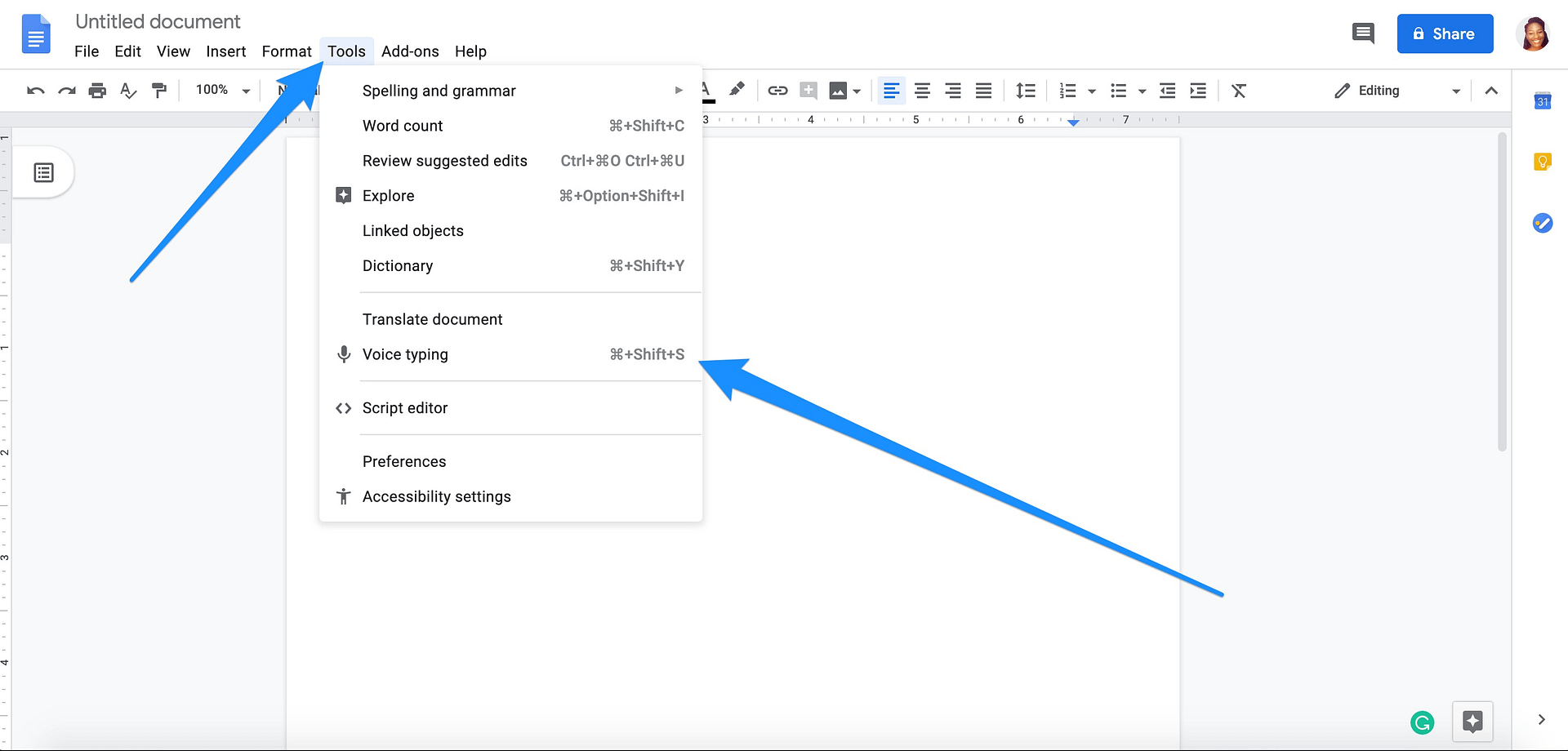If your job requires using a computer a lot, you’ll want to do what you can to prevent repetitive strain injury from typing.
If you are employed, you can speak to your employer for support, if you are concerned about repetitive strain injury (RSI); but what do you do if you’re self-employed?
Table of Contents
- Improve your posture to prevent repetitive strain injury from typing
- Understand the warning signs of Repetitive Strain Injury
- Use a vertical mouse
- Take regular breaks from typing
- Do exercises to prevent repetitive strain injury from typing
- Warm up and cool down before and after typing
- Change your typing habits
- Use an ergonomic keyboard
- De-stress to prevent repetitive strain injury
- Dismiss the myths
- Practise your typing skills
- Use speech recognition software
- Reduce the amount of typing you have to do
- Follow Repetitive Strain Injury Experts
- Treatment options for repetitive strain injury from typing
- Implement these tips to prevent repetitive strain injury from typing
As a freelance digital copywriter, working from home, a typical day for me involves typing thousands of words over a long period of time.
I sometimes suffer from wrist and finger pain from typing too much, which slows me down.
So I did a bit of research to see what I could do to prevent or minimise these effects.
I’m not a medical professional, I’m just sharing some of the things that have worked for me. If you think you have RSI and are concerned that it is not getting any better, I’d definitely encourage you to see your GP.
Your GP will be able to thoroughly examine the affected area. They’ll ask about your medical history and determine if you have any underlying medical conditions worsening the symptoms.
They may be able to recommend something anti-inflammatory or advise you to wear a splint (splinting is a medical procedure and should be done under the supervision of a doctor).
So with that said here are some of the things that have helped me to prevent repetitive strain injury from typing.
Improve your posture to prevent repetitive strain injury from typing
Before setting up my workspace at home, I used to work from my sofa, or even whilst in bed. Not placing my laptop on a flat sturdy surface resulted in wrist pain from typing.
Whilst it is nice working from the sofa occasionally, over the long-term it promotes a poor posture.
Maintaining a good posture whilst working is extremely important especially if you’ll be working from home.
Here’s a really good annotated graphic from career midway explaining the correct posture for using the computer.

Here’s a video by David Zhang with tips on maintaining the correct posture whilst working at your desk.
Quick actions you can take to improve your posture when working & prevent repetitive strain injury
- Invest in an ergonomic, adjustable office chair. Once your chair arrives, spend some time adjusting it to your needs.
- Get yourself an under desk footrest (or improvise with a raised flat surface) to support your feet.
- If you are considering getting a new desk, look into getting a standing desk. This will give you the option to work standing up some days and sitting on others.
- Be extremely careful if you use a wrist rest as these may put your wrists in an awkward position. Remember the aim is to keep your wrists in a neutral position.
It’s a good idea to work on improving your posture regardless of whether you are standing up or sitting down.
When seated, you should elongate your spine, lift the ribs off the waist, keep your shoulder blades flat and your neck long.
Avoid slumping over whilst working to give your lungs more room to inflate.
If poor posture is an issue for you, look into the Alexander technique. It is a technique that teaches improved posture and movement and prevents problems caused by bad habits.
Understand the warning signs of Repetitive Strain Injury
The symptoms may vary from person to person, so you should seek medical advice from your GP to discuss your symptoms.
Repetitive strain injury can affect the neck, shoulders, upper back, upper arm, elbows, wrists or forearms.
Here are some of the warning signs of RSI. It is important that you don’t ignore them otherwise it can get worse.
- Difficulty using your hands for everyday tasks like turning on the tap or opening doors
- Pain or soreness (although RSI is not always painful)
- Stiffness
- Difficulty opening and closing your hands
- Tingling, numbness or loss of sensation
- Difficulty buttoning clothing and putting on clothing
If you recognise what you were doing when these symptoms arose you can take actions to prevent it from happening again.
For example, if you started to experience these symptoms after typing for 8 hours straight without a break, you’ll ensure that you take frequent breaks.
Use a vertical mouse
During extended sessions of using my laptop, the motion of switching between typing on the keyboard and the touchpad would sometime start to cause pain down the centre of my hand to my wrist.
If you’re experiencing wrist pain from using your mouse read on!
One way to combat this pain is to use a mouse with your laptop instead of the trackpad.
Tip: Try to keep the mouse as close to you as possible to avoid unnecessary stretching.
You might also find getting an ergonomic mouse useful. These vertical ergonomic mice seem to put less strain on my wrist by instead using the larger muscles in the arm.
When it comes to moving the mouse instead of bending the wrist, you’ll pivot your elbow which may help to alleviate some of the strain.
Here’s a great video by Steve Meagher aka “The Ergonomics Guy” on how to select the right mouse.
If you have already tried a variety of mice but find clicking to be painful, consider downloading an automatic clicking tool.
This software will automatically click for you when you hover the cursor over certain items.
Tips for using your mouse to prevent RSI from work:
- click gently, with minimal pressure
- don’t hold the mouse too tightly
- move the mouse from your shoulder
- keep the mouse level with your keyboard
Take regular breaks from typing
Repetitive tasks like typing can increase the chances of getting RSI or carpal tunnel syndrome.
RSI is related to overusing the muscles and tendons in the upper body, hence why it is sometimes referred to as upper limb disorder.
Overuse can result in micro-tears in the soft tissues which can become swollen and painful.
Furthermore, repetitive movements can also damage tendons. Continuous strain on your tendons can lead to tears. Without adequate rest, these tendons won’t get a chance to heal. In severe cases, this can lead to permanent tendon damage.
It can be difficult to schedule in regular breaks if you are particularly busy. However, it is important if you want to prevent getting a RSI from work.
Taking breaks allows the body to repair itself. If you try to work through the pain without taking any action, the problem will continue to get worse.
The key is to take breaks before the symptoms of repetitive strain injury from typing arises. If you start to experience pain, this is an indication that you haven’t been taking breaks frequently enough.
If you have the tendency to forget to take breaks whilst working set timers or reminders on your phone, or use the Pomodoro technique.
Do exercises to prevent repetitive strain injury from typing
Typing is a pretty sedentary task.
When you hold a sedentary posture for too long circulation can be impeded.
Over time this can result in waste products building up and diminished oxygen supply. This can impair muscle function over time.
This can be prevented by taking breaks frequently and going some exercise.
During your breaks spend 2 minutes performing exercises for repetitive strain injury.
Here’s a video tutorial demonstrating some wrist exercises for preventing repetitive strain injury and carpal tunnel.
You might find it useful to use hand exercisers for a few minutes during your breaks.
Using a stress ball or therapy putty may help to relieve symptoms of RSI.
Warm up and cool down before and after typing
As with everything in life, preparation is key!
Before a long typing session remove any heavy or chunky jewellery such as rings or bracelets.
Do some stretches and hand exercises before and after typing sessions.
Tip: place both palms together then rotate both wrists in circles.
Change your typing habits
I used to have a really bad habit of typing with one hand.
Usually, I’d naturally type with one hand whilst lounging on the sofa. I’d have my left hand holding up my head whilst my right hand did all the typing. 🙈
Over time I was able to type quite quickly with just my right hand, but I did notice the increased strain on my right wrist and hand.
Positioning both hands so that your left index finger is on the ‘F’ key and that your right index finger is on the ‘J’ key will help to balance out the typing movements between both hands.
Another bad typing habit I used to have was forcefully typing.
I used to type so loud that I have woken up family members in the past! 🤭
Get into the habit of pressing the keys more gently and applying even pressure on all keys.
When you need to use any of the keys on the top row of the keyboard get into the habit of not stretching to reach them.
Instead, move your whole hand towards the keys that are harder to reach.
Here’s an informative video on how to preserve your carpal tunnel whilst typing to prevent RSI and related conditions.
Use an ergonomic keyboard
As shown in the video above, the key is to keep your wrists in a neutral position (this involves keeping your wrists straight) to preserve your carpal tunnel.
It is quite common for people using desktop keyboards to type with their wrists bent upwards towards.
This is known as dorsiflexion of the wrist and is often a result of a poorly angled keyboard.
You might need to try a few different types of keyboards or even switch your keyboards periodically to use the one that is most comfortable for you.
If you haven’t already, consider getting an ergonomic keyboard.
Ergonomic keyboards are designed to reduce muscle strain and related problems.
The keys on an ergonomic keyboard is often V-shaped to keep your wrists in a natural position.
Keyboards that aren’t split into two separate sections force you to type with your hands close together which causes you to twist your wrists.
Tip: If you are experiencing wrist pain from typing on your laptop keyboard, you can use an external ergonomic keyboard.
De-stress to prevent repetitive strain injury
Being self-employed can be extremely stressful at times!
Stress can lead to several health problems.
It can even be a contributing factor to the symptoms of RSI.
Try to build in methods of reducing your stress levels whilst working.
This is where taking regular breaks and fitting in some exercise during the day might help.
You might also want to consider making some changes to your work environment, to make it as comfortable as possible.
Tip: make sure the temperature of the room is comfortable, as cold temperatures can contribute to making RSI worse.
One way to de-stress is to get active.
Physical movement will help to reduce emotional intensity if you are feeling stressed. It can help to clear your mind and help you to deal with problems calmly.
During your breaks or during your free time you could squeeze in a 30-minute yoga session. Here’s a tutorial by Adriene.
Caution: If you are currently experiencing symptoms of RSI, be extremely cautious when doing yoga or other physical activities. You don’t want to make your condition worse.
If you can, speak to a yoga instructor with experience of RSI. They should be able to adapt the routine to your individual needs.
Another way to de-stress whilst working at your computer is to practise deep breathing.
Sometimes whilst we are typing away, or working towards tight deadlines, our breathing can become more shallow. This often happens without us even realising it.
Here are some tips on how you can make deep breathing a habit whilst working on the computer.
The video above also has some good tips on reducing eye strain whilst using the computer.
Dismiss the myths
There are quite a few RSI myths out there. It’s important to dispell these myths so that you can take the right steps to protect your hands and wrists and prevent getting repetitive strain injuries.
Myth 1: I don’t type all day so I’m not at risk
Using a computer for as little as 2 hours per day can increase your risk of developing RSI.
It’s not just about the volume of typing you do but factors such as a poor workspace that can put you at risk.
Myth 2: Rest will make my injury go away
Early symptoms of repetitive strain injury may be intermittent. Without seeking treatment, you may cause yourself permanent damage.
Myth 3: RSI is the same as Carpal tunnel
RSI is an umbrella term for a range of different injuries including carpal tunnel.
Practise your typing skills
The more you practise typing using good habits you’ll start to notice the reduced strain on your hand, arms and wrists.
Get into a routine of making sure that you have a good posture whilst typing.
This will involve making sure that you sit with your feet flat on the floor and position the top of the screen so that it is at or slightly below eye level.
Practising your typing skills will increase your typing accuracy and speed which will help to boost your productivity.

Use speech recognition software
Speech recognition technology has definitely improved over the years!
If you notice that you are developing finger or wrist pain from typing on your laptop or desktop computer, use speech recognition software whilst you rest your hands.
Google docs has a voice typing feature that allows you to talk whilst it types for you.

There are other voice typing programs out there but I’d recommend trying out the one on Google docs first as it is free!
Reduce the amount of typing you have to do
This might sound impossible, but there are some great ways you can reduce the amount of typing you do each day.
We already covered using speech recognition to reduce your amount of physical typing.
Autosuggest
Other than voice typing you can enable autosuggest where possible.
For example, in Gmail you can enable the autosuggest setting. Once you’ve done this Gmail will finish your sentences like this:

Keyboard shortcut software
you can download tools such as aText to create shortcuts for things that you type regularly.
Tools like these are great for productivity too!
Password managers
Logging into different sites every day increases the amount of typing you do whilst also taking up valuable time.
Using a password manager will automatically fill in your login credentials!
I use LastPass – it basically remembers all of my login details for over 200 websites so that I don’t have to!
Tip: If you take a holiday or some time off work, ease your self back into work carefully upon your return.
Follow Repetitive Strain Injury Experts
Deborah Quilter is considered to be a pioneer in the field of Repetitive Strain Injury.
She has written two books on the topic: Repetitive Strain Injury: A Computer User’s Guide and The Repetitive Strain Injury book.
She also has a podcast called RSI help with Deborah Quilter where she shares tips on how to prevent and cope with repetitive strain injury.
Treatment options for repetitive strain injury from typing
Before wrapping up this post, I’d like to go through some of the treatment options available.
If you’ve taken actions to improve your condition, or are concerned the first step is to see your GP.
Treatment options for RSI may include:
- Applying a cold pack to the affected area. You can get a wrist ice pack wrap which is a wrist support with a built-in gel pack to help soothe your soft tissues and reduce pain.
- Elastic supports to help keep your wrists in a straight, neutral position
- Yoga with an instructor specialising in RSI. Here are 6 yoga poses for RSI BY Yoga International.
- Medications or surgery. In more severe cases your doctor may prescribe anti-inflammatory medicines or steroid injections. Your Dr may also recommend surgery if other treatments have not helped.
- If you are in the UK, your Dr may refer you to see a physiotherapist, massage therapist or an osteopath.
Implement these tips to prevent repetitive strain injury from typing
Those are all of my tips on how to prevent repetitive strain injury from typing.
I hope you find them useful. If you try some methods of reducing RSI but do not notice a difference, book an appointment with your GP.
As a freelancer, it will be your responsibility to take actions in order to prevent, reduce and treat the symptoms of RSI to maintain your health.
It’s really important to take actions in treating the symptoms!
Don’t:
- Wait until the pain is so bad that you can’t work. If you get the right treatment as soon as the first sign of an injury arises, you’ll increase your chances of recovery.
- Work through the pain as this could lead to carpal tunnel syndrome or other conditions.
- Ignore the symptoms and not make any changes as this can result in permanent damage.
Do:
- Make it a priority to protect your wrists and hands
- Invest in creating an ergonomic workspace at home by getting an ergonomic chair, desk, keyboard and mouse.
- Take frequent breaks as repetitive tasks like typing and using a mouse can fatigue the muscles in your forearm and hand. Rest gives the body time to repair itself.
- Get active every day by exercising and stretching.
- Pace yourself. Constantly using the same muscle groups without adequate breaks isn’t a good idea, so be sure to break up your workday.
- Reduce the amount of typing you need to do where possible. If you have had a day where you have done more typing than usual be sure to rest your hand after work instead of engaging in activities that use the hands such as bowling or playing video games.
- Continually seek to improve your posture
- Ensure that you know the signs of a developing RSI.
Don’t forget to check out our other posts here at Resources for Freelancers!




